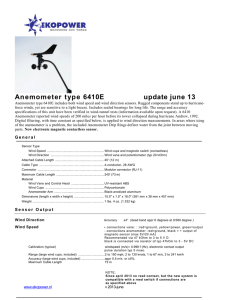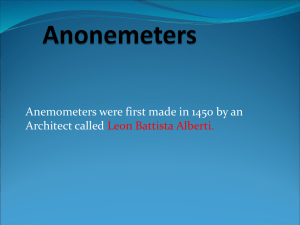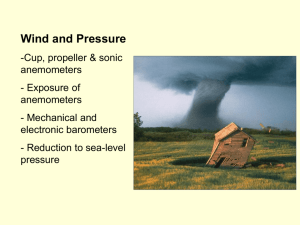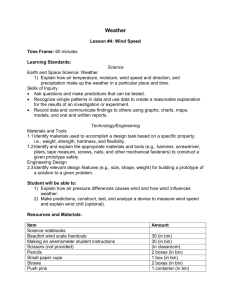View/Open - CIIT Lahore Repository
advertisement
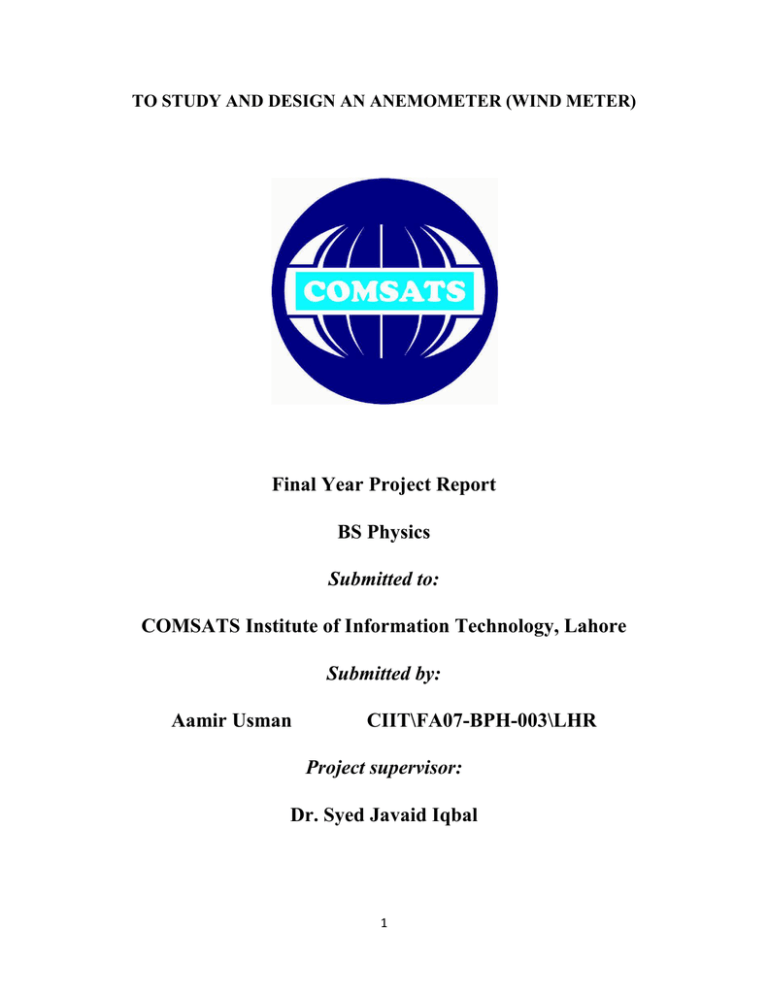
TO STUDY AND DESIGN AN ANEMOMETER (WIND METER) Final Year Project Report BS Physics Submitted to: COMSATS Institute of Information Technology, Lahore Submitted by: Aamir Usman CIIT\FA07-BPH-003\LHR Project supervisor: Dr. Syed Javaid Iqbal 1 2 DEDICATION To, My Respected Parents Guiding Teachers And Supporting Friends 3 Project Report Submitted by Aamir Usman For BS Physics Has been approved for COMSATS Institute of Information Technology, Lahore External Examiner: -------------------------Dr. Anwar Butt Assistant Professor Department of Physics UET, Lahore-Pakistan Internal Examiner: -------------------------Muhammad Naveed Aslam Lecturer Department of Physics CIIT, Lahore-Pakistan Supervisor: ----------------------------------Dr. Syed Javaid Iqbal Chief Scientific officer Department of Physics, CIIT, Lahore, Pakistan Head of the Department: ---------------------------- Dr. Ashfaq Ahmed Professor Department of Physics, CIIT, Lahore, Pakistan Dean, Faculty of Sciences: ------------------------------- Prof. Dr. Arshad Saleem Bhatti CIIT, Islamabad 4 DECLARATION I certify that in the final project submission I have not presented or attempted to present anyone else’s work as my own except where I have explicitly so indicated. I understand that to do so would mean that I had committed plagiarism. I re-confirm my consent to the University copying and distributing any or all of my work in any form for assessment purpose, to verify whether my work contains plagiarised material, and for quality assurance purposes. Aamir Usman CIIT\FA07-BPH-003\LHR 5 CERTIFICATE It is certified that Amir Usman has carried out all the work related to his undergraduate final year project report under my supervision at the Department of Physics, COMSATS Institute of Information Technology, Lahore. Supervisor Dr. Syed Javaid Iqbal Chief Scientific officer Submitted through: Dr. Ashfaq Ahmed Head of the Department Department of Physics CIIT, Lahore 6 ABSTRACT I have designed an anemometer. The main structure is made up of soft wood. Four hemispherical cups fixed on the thin needle like rotating rod. When wind passes through these hemispherical cups then they start rotating according to the speed of wind. A counter circuit is designed to display the reading. The reading of the counter is dependent on the input signal. The counter counts and shows the reading on the 7segments display and then holds. I reset the counter manually and the reading becomes zero and then the counter start count again. 7-segments are used to display counts. whole circuit is designed and developed since count is dependent on input. After each count output is rest manually. 7 ACKNOWLEDGEMENTS “He is Allah, the Creator, the Maker, the Fashioner. His Names are the most beautiful names. All that is in the heavens and the earth glorifies Him, and He is the Mighty, the Wise.” (Al hasher 25 Al-Quran) “One who treads a path in search of knowledge has his path to Paradise made easy by God…” (Hadith) It is my privilege to express my sincerest regards to my project supervisor, Dr.Syed Javaid Iqbal, for his valuable inputs, able guidance, encouragement, whole-hearted cooperation and constructive criticism throughout the duration of my project. As my teacher and mentor, he has taught me more than I could ever give him credit for here. Nobody has been more important to me in the pursuit of this project than the members of my family. I would like to thank my parents, whose love and guidance are with me in whatever I pursue. They are the ultimate role models. I take this opportunity to thank all my respected teachers who have directly or indirectly helped me in my project. I pay my respects and love to my siblings and all my friends for their love and encouragement throughout my career. Aamir Usman 8 “With faith, discipline and selfless devotion to duty, there is nothing worthwhile that you cannot achieve.” Muhammad Ali Jinnah 9 TABLE OF CONTENTS 1. INTRODUCTION………………………………………………………...……….1 1.1 Defination…………...……………………………………………..…..…. 2 1.2 Different type of anemometers…………………………………………... .2 1.2.1 Cup anemometers.…………………………………………….... 2 1.2.2 Three cup anemometers……………………………………........ 3 1.2.3 Windmill anemometers………………………………….…..…... 4 1.2.4 Hot wire anemometers……………........................................... 4 2. EXPERIMENTAL WORK ………………………………………………......….. 6 2.1 Apparatus ...……………………………………………………..……….....6 2.2 Apparatus description ……..…………………..…………...……..…..……6 2.2.1 Bread board …………………………………..............................6 2.2.2 Capacitor ………………………………………………….…....... 7 2.2.3 Resistances ………………………………...................................7 2.2.4 Ic’s ………………………………………………….……………..9 2.2.5 LED ……………………………………………………........... 10 2.2.6 Seven segment display …………………………………….….. 10 2.2.7 Connecting wires ……………………………….……..………. 11 10 2.2.8 Adapter ………………………………………….……..…........ 11 2.3 Construction……..………………………………………….….…………..12 2.3.1 Wind speed detector…………………………….….….………....12 2.3.2 Electronic for calculation and display………………………........13 3. RESULTS AND DISCUSSIONS……………………………………..…………....17 4. REFERENCES………………………………………………………………………19 11 LIST OF FIGURES Figure 1.1 Anemometer working on air port……………………………………………………..1 Figure 1.2 Anemometer working on weather station……………………………………………..2 Figure 1.3 Hemispherical cup anemometer invented by John Thomas Romney Robinson……...3 Figure 1.4 A windmill style of anemometer……………………………………………………...4 Figure 1.5 Hot-wire sensor………………………………………………………………….….…4 Figure 2.1 Bread board……………………………………………………………..……………..6 Figure 2.2 Capacitor………………………………………………………………………………7 Figure 2.3 Resistance……………………………..………………………………….…...………7 Figure 2.4 74LS193……………………………………………………………………………….9 Figure 2.5 74LS47 the driver for 7-segment display……………………………………………..9 Figure 2.6 74LS125……………………………………………………………………………….9 Figure 2.7 LED………………………………………………………………………………….10 Figure 2.8 Three digits seven segment display…………………………………………...……..10 Figure 2.9 Connecting wires………………………………………………………………….....11 Figure 2.10 Adopter……………………………………………………………………………..11 Figure 2.11 Wooden frame……………………………………………………………………...12 Figure 2.12 Needle like thin rod………………………………………………………………...12 Figure 2.13 Hemispherical cups…………………………………………………………….......13 Figure 2.14 Triple five timer………………………………………………………………….....13 Figure 2.15 74LS193…………………………………………………………………………….14 Figure 2.16 74LS47 Ic……………………………………………………...…………………...14 Figure 2.17 7-Segment displays………………………………………………………………...15 12 Figure 2.18 74LS125 Ic……………………………………………….…….………….……….15 Figure 2.19 Counter circuit……………………………………………….….….……..………..16 Figure 3.1 Counter circuit on hold state………………………………………..…………….….17 13 Chapter 1 1. Introduction Anemometer is commonly used instrument in weather stations for measuring wind speed which is important factor in field of wind energy. The first known description of an anemometer was given by Leon Battista Alberti around (1450). Why we use anemometer? A wind meter, or anemometer, is often used to monitor conditions related to air travel, industrial work sites, and marine travel. An anemometer can provide important information for pilots, industrial workers, sailors, weather stations and even researchers. Air Ports Depending on location an airport may have anemometer. Pilots need both speed of wind and wind pattern information for safe take-off and landings of plans. Varying wind speed and patterns may affect flight, especially in areas where mountainous regions surround valleys. Crop dusters and aerial fire fighters also need to know wind speed and direction in order to safely and efficiently deliver any chemicals dropped from the plane. Hang gliders, hot air balloonists, and model airplane enthusiasts, might all use wind speed indicators to determine flying conditions. Figure 1.1 anemometers working on air port Weather stations 14 Figure 1.2 Anemometer working on weather station Weather stations constantly monitor wind direction and speed and relay that information to the public. Anemometers can allow meteorologists to predict the arrival time of storm fronts and changing weather patterns. [1] 1.1 Definition An anemometer is a device use for measuring wind speed. The term anemometer is derived from the Greek word anemos, meaning wind. [2] 1.2 Different type of anemometers Different types of anemometers are used for the measurement of wind speed. Few types of anemometers are discus below. 1.2.1 Cup anemometers There are many instruments to measure the speed of wind but cup anemometer is mostly using device due to its low cost. A simple type of anemometer was invented in 1846 by Dr. John Thomas Romney Robinson. It is consisted of four hemispherical cups. Each cup is mounted on one end of four horizontal arms, which in turn were mounted on a vertical shaft. The air flow past the cups in any horizontal direction turned the cups in a manner that was proportional to the wind speed. Therefore, counting the turns of the cups over a set time period produced the average wind speed for a wide 15 range of speeds. On an anemometer with four cups it is easy to see that since the cups are arranged symmetrically on the end of the arms, the wind always has the hollow of one cup presented to it and is blowing on the back of the cup on the opposite end of the cross. Figure 1.3 A hemispherical cup anemometer of the type invented in 1846 by John Thomas Romney Robinson. 1.2.2 Three cup anemometers The three cup anemometer developed by the Canadian John Patterson in 1926 and subsequent cup improvements by Brevoort & Joiner of the USA in 1935 led to a cupwheel design which was linear and had an error of less than 3% up to 60 mph (97 km/h). Patterson found that each cup produced maximum torque when it was at 45 degrees to the wind flow. The three cup anemometer also had a more constant torque and responded more quickly to gusts than the four cup anemometer. Three cup anemometers are currently used as the industry standard for wind resource assessment studies. [3] 1.2.3 Wind mill anemometers 16 Figure 1.4 A windmill style of anemometer The other forms of mechanical velocity anemometer may be described as belonging to the windmill type anemometer. In the Robinson anemometer the axis of rotation is vertical, but with this subdivision the axis of rotation must be parallel to the direction of the wind and therefore horizontal. 1.2.4 Hot wire anemometers Figure 1.5 Hot-wire sensor which uses the rate at which heat from a hot wire is transferred to the surrounding air to measure wind speed? Hot wire anemometers use a very fine wire (on the order of several micrometers) electrically heated up to some temperature above the ambient. Air flowing past the wire has a cooling effect on the wire. As the electrical resistance of most metals is dependent upon the temperature of the metal (tungsten is a popular choice for hot-wires), a relationship can be obtained between the resistance of the wire and the flow speed. [4-5] 17 Chapter 2 2 Experimental Work I use the following apparatus to design the anemometer (wind meter) 2.1 Apparatus Apparatus for wind speed detector 1. A wooden Frame 2. Four cups 3. Long needle like rod Apparatus for wind speed detector 1. 2. 3. 4. 5. 6. 7. Bread board Capacitor Resistances IC’s LED 7 segment display Connecting wires 8. Adopter 2.2 Apparatus description 2.2.1 Bread board Figure2.1 Bread board 18 A breadboard is used to make temporary circuits for testing. No soldering is required so that it is easy to change connections and replace components. Components will not be damaged so that they will be available to re-use. 2.2.2 Capacitor Figure 2.2 Capacitor Capacitor is just two parallel plates separating by dielectric material and is used to store charge. 2.2.3 Resistances Figure2.3 Resistance Resistance is an electrical component which opposes the flow of electric current. The SI unit of electrical resistance is the ohm (Ω). 19 How to read the value of resistance? Black Brown Red Orange Yellow Green Blue Violet Gray White 0 1 2 3 4 5 6 7 8 9 Color code First find the tolerance band, it will typically be gold ( 5%) and sometimes silver (10%). Starting from the other end, identify the first band - write down the number associated with that color; in this case Brown is 1. Now 'read' the next color, here it is black so write down a '0' next to the one. (you should have '10' so far.) Now read the third or 'multiplier exponent' band and write down that as the number of zeros. In this example it is two so we get '1000' or '1,000'. If the 'multiplier exponent' band is Black (for zero) don't write any zeros down. If the tolerance band is Gold then it is indicating that the actual resistance value is with + or - 5% of the nominal value, and If the tolerance band is Silver then it is indicating that the actual resistance value is with + or - 10% of the nominal value. In this example the tolerance band is gold so we write 1000 ± 5%. So the given resistor is of value 1KΩ.[6] 20 2.2.4 IC’s I have used the following IC’s in my project. Figure2.4 74LS193 Figure2.5 74LS47 is the driver for seven segment display. Figure 2.6 74LS125 21 2.2.5 LED Figure 2.7 LED LED’s are the light emitting diodes made up of semiconductor material like silicon. 2.2.6 Seven segment display Figure 2.8 Three digits seven segment display 22 2.2.7 Connecting wires Figure2.9 Connecting wires Connecting wires are used to make connections in the circuits. They are available in different colors but all are used for same purpose. 2.2.8 Adapter Figure 2.10 Adopter to give the supply to the circuit 23 2.3 Construction There are following two parts of construction. 2.3.1 Wind speed detector In order to design wind speed detector following steps are followed. First of all I design a wooden frame. Figure 2.11 Wooden Frame Needle like thin rotating rod is adjust at the one end of the wooden frame. Figure 2.12 Needle like thin rod 24 Four hemispherical cups each fixed at one end of four horizontal arms which are fixed on rotating rod. Figure 2.13 Hemispherical Cups I attached the IR radiator and IR detector to the wooden frame and attached the card to the moving needle in that way that it cuts the IR radiation so in this way signal is produced and then this signal is sent to the electronic circuit for the display of reading. 2.3.2 Electronic for calculation and display First of all I make a triple five timer to create output signal. S.No Components Values 1 R1 (Resistor) 10 KΩ 2 R2 (Resistor) 100 KΩ 3 Capacitor 100μF Figure 2.14 Triple five timer 25 The input signal then goes to the 74LS193 IC. Figure 2.15 74LS193 The signal then passes through 74LS47 IC which is the driver for the seven segment display. Figure 2.16 74LS47 IC 26 The signal goes to the 7-segment display. Figure 2.17 7-segment display I use IC 74LS125 to hold the reading until reset. Figure 2.18 74LS125 IC 27 So in this way the seven segment display gives us the reading. Figure 2.19 Counter circuit The counter that I make is hexadecimal counter. Hexadecimal (often just called 'hex') is base 16 counting with 16 digits. It starts with the decimal digits 0-9 as then continues with letters (0), (1), (2) , (3), B (11), C (12), (4), (5), (6), (7), (8), (9) then continues with letters D (13), E (14) and block F (15) A (10), I connect the two counters by connecting the clear terminals of both 74LS193 the IC’s to clear the reading of the both digits of 7-segment display at the same time and I connect the count up terminal of one and the carry terminal of the other 74LS193 IC. In this way when the second digit of the 7-segment starts counting and reaches up to 15 then it carry to the first digit of 7segment display which as a result becomes 1 and the second digit start counting again and when it reaches at 15 it generate carry again to the first digit which become 2 as a result and similarly the counter continues counting. Example 100 kΩ resistance is connected in 6th and 7th terminal of 555 timer the 2nd digit of 7-segment display start counting after 15 F reaches it carry to the first digit and it becomes 1 and second digit start counting again and stops at F block. So in case of 100 kΩ the reading showed by the counter is 1F (hexadecimal). 28 Chapter 3 Results and discussion I successfully make anemometer structure and a counter circuit and both of them are working condition. My counter counts the signal and displays the reading on 7-segment display and then holds. I have to reset the counter manually with the help of switch because I make a simple counter circuit which cannot be reset automatically. The counter works perfectly and the reading depends upon the input signal. If the resistance from the 6th, 7th terminal of 555 timer is of the greater value then the counter counts for a long time and then shows the reading on the 7-segment display and holds for the as counter time. If the resistance is of the small value the counter counts for the short time and then displays the reading on the 7-segment display and then holds for the as counter time. If I reset the reading then it will go back to zero and if I do not reset the counter then the next reading will add up to the previous one. Figure 3.1 Counter circuit in hold state This counter will be use to count the rotation of hemispherical cups of the wind speed detector. When the speed of wind is greater the cups rotate faster then the signal is sent to the counter by 29 using IR emitter detector pair. And the counter receives the signal and starts counting and then holds and displays the reading on the 7-segment display. Errors An error occurred naturally in the wind speed detector it is due to the factor that the anemometer responds more quickly and due to momentum when the speed of the wind increase but it responds comparatively slowly when the speed of the wind decreases. Another factor is the friction between the rotating needle and the steel on the ends of the wooden frame. The working of anemometer can be improved by decreasing the friction but I can’t remove it completely. [7] Conclusion I managed to make Anemometer also design. IS also mage counter but we could not calibrate it because I do not have standard anemometer. Future work For future I expect people will continue this project and calibrate it with same standard wind speed anemometer. 30 4. REFERANCES 1. Dines, William Henry. Anemometer. 1911 Encyclopædia Britannica. 2. Meteorological Instruments, W.E. Knowles Middleton and Athelstan F. Spilhaus, Third Edition revised, University of Toronto Press, Toronto, 1953. 3. Invention of the Meteorological Instruments, W.E. Knowles Middleton, The Johns Hopkins Press, Baltimore, 1969. 4. http://www.wisegeek.com/what-are-the-different-uses-of-a-wind-speed-indicator.htm. 5. http://www.tititudorancea.com/z/what_is_an_anemometer.htm 6. http://wiki.xtronics.com/index.php/Resistor_Codes 7. Coppin, P. A. (1982), ‘Cup anemometer overspeeding’, Meteorol. Rdsch. 31


